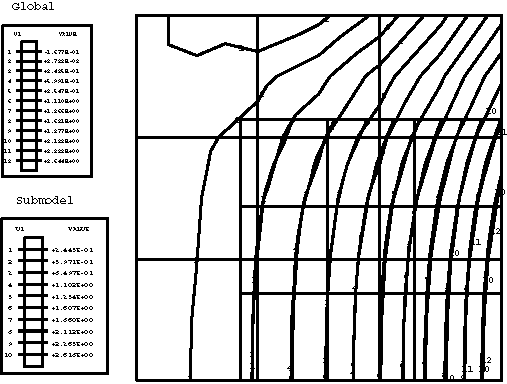- pgc38ths.inp
-
C3D8HT elements; global analysis.
- psc38ths.inp
-
C3D8HT elements; submodel analysis.
- pgc38tys.inp
-
C3D8RHT elements; global analysis.
- psc38tys.inp
-
C3D8RHT elements; submodel analysis.
- pgc38trs.inp
-
C3D8RT elements; global analysis.
- psc38trs.inp
-
C3D8RT elements; submodel analysis.
- pgc38tfs.inp
-
C3D8T elements; global analysis.
- psc38tfs.inp
-
C3D8T elements; submodel analysis.
- pgc3kths.inp
-
C3D20HT elements; global analysis.
- psc3kths.inp
-
C3D20HT elements; submodel analysis.
- pgc3ktys.inp
-
C3D20RHT elements; global analysis.
- psc3ktys.inp
-
C3D20RHT elements; submodel analysis.
- pgc3ktrs.inp
-
C3D20RT elements; global analysis.
- psc3ktrs.inp
-
C3D20RT elements; submodel analysis.
- pgc3ktfs.inp
-
C3D20T elements; global analysis.
- psc3ktfs.inp
-
C3D20T elements; submodel analysis.
- pgca4ths.inp
-
CAX4HT elements; global analysis.
- psca4ths.inp
-
CAX4HT elements; submodel analysis.
- pgca4tys.inp
-
CAX4RHT elements; global analysis.
- psca4tys.inp
-
CAX4RHT elements; submodel analysis.
- pgca4trs.inp
-
CAX4RT elements; global analysis.
- psca4trs.inp
-
CAX4RT elements; submodel analysis.
- pgca4tfs.inp
-
CAX4T elements; global analysis.
- psca4tfs.inp
-
CAX4T elements; submodel analysis.
- pgca6ths.inp
-
CAX6MHT elements; global analysis.
- psca6ths.inp
-
CAX6MHT elements; submodel analysis.
- pgca6tfs.inp
-
CAX6MT elements; global analysis.
- psca6tfs.inp
-
CAX6MT elements; submodel analysis.
- pgca8ths.inp
-
CAX8HT elements; global analysis.
- psca8ths.inp
-
CAX8HT elements; submodel analysis.
- pgca8tys.inp
-
CAX8RHT elements; global analysis.
- psca8tys.inp
-
CAX8RHT elements; submodel analysis.
- pgca8trs.inp
-
CAX8RT elements; global analysis.
- psca8trs.inp
-
CAX8RT elements; submodel analysis.
- pgca8tfs.inp
-
CAX8T elements; global analysis.
- psca8tfs.inp
-
CAX8T elements; submodel analysis.
- pgca3hhs.inp
-
CGAX3HT elements; global analysis.
- psca3hhs.inp
-
CGAX3HT elements; submodel analysis.
- pgca3hfs.inp
-
CGAX3T elements; global analysis.
- psca3hfs.inp
-
CGAX3T elements; submodel analysis.
- pgca4hhs.inp
-
CGAX4HT elements; global analysis.
- psca4hhs.inp
-
CGAX4HT elements; submodel analysis.
- pgca4hys.inp
-
CGAX4RHT elements; global analysis.
- psca4hys.inp
-
CGAX4RHT elements; submodel analysis.
- pgca4hrs.inp
-
CGAX4RT elements; global analysis.
- psca4hrs.inp
-
CGAX4RT elements; submodel analysis.
- pgca4hfs.inp
-
CGAX4T elements; global analysis.
- psca4hfs.inp
-
CGAX4T elements; submodel analysis.
- pgca6hhs.inp
-
CGAX6MHT elements; global analysis.
- psca6hhs.inp
-
CGAX6MHT elements; submodel analysis.
- pgca6hfs.inp
-
CGAX6MT elements; global analysis.
- psca6hfs.inp
-
CGAX6MT elements; submodel analysis.
- pgca8hhs.inp
-
CGAX8HT elements; global analysis.
- psca8hhs.inp
-
CGAX8HT elements; submodel analysis.
- pgca8hys.inp
-
CGAX8RHT elements; global analysis.
- psca8hys.inp
-
CGAX8RHT elements; submodel analysis.
- pgca8hrs.inp
-
CGAX8RT elements; global analysis.
- psca8hrs.inp
-
CGAX8RT elements; submodel analysis.
- pgca8hfs.inp
-
CGAX8T elements; global analysis.
- psca8hfs.inp
-
CGAX8T elements; submodel analysis.
- pgce4ths.inp
-
CPE4HT elements; global analysis.
- psce4ths.inp
-
CPE4HT elements; submodel analysis.
- pgce4tys.inp
-
CPE4RHT elements; global analysis.
- psce4tys.inp
-
CPE4RHT elements; submodel analysis.
- pgce4trs.inp
-
CPE4RT elements; global analysis.
- psce4trs.inp
-
CPE4RT elements; submodel analysis.
- pgce4tfs.inp
-
CPE4T elements; global analysis.
- psce4tfs.inp
-
CPE4T elements; submodel analysis.
- pgce4tfsg.inp
-
CPE4T elements; SUBMODEL, GLOBAL ELSET; global analysis.
- psce4tfsg.inp
-
CPE4T elements; SUBMODEL, GLOBAL ELSET; submodel analysis.
- pgce6ths.inp
-
CPE6MHT elements; global analysis.
- psce6ths.inp
-
CPE6MHT elements; submodel analysis.
- pgce6tfs.inp
-
CPE6MT elements; global analysis.
- psce6tfs.inp
-
CPE6MT elements; submodel analysis.
- pgce8ths.inp
-
CPE8HT elements; global analysis.
- psce8ths.inp
-
CPE8HT elements; submodel analysis.
- pgce8tys.inp
-
CPE8RHT elements; global analysis.
- psce8tys.inp
-
CPE8RHT elements; submodel analysis.
- pgce8trs.inp
-
CPE8RT elements; global analysis.
- psce8trs.inp
-
CPE8RT elements; submodel analysis.
- pgce8tfs.inp
-
CPE8T elements; global analysis.
- psce8tfs.inp
-
CPE8T elements; submodel analysis.
- pgcg3tfs.inp
-
CPEG3T elements; global analysis.
- pscg3tfs.inp
-
CPEG3T elements; submodel analysis.
- pgcg4tys.inp
-
CPEG4RHT elements; global analysis.
- pscg4tys.inp
-
CPEG4RHT elements; submodel analysis.
- pgcg4trs.inp
-
CPEG4RT elements; global analysis.
- pscg4trs.inp
-
CPEG4RT elements; submodel analysis.
- pgcg4tfs.inp
-
CPEG4T elements; global analysis.
- pscg4tfs.inp
-
CPEG4T elements; submodel analysis.
- pgcg4tfsg.inp
-
CPEG4T elements; SUBMODEL, GLOBAL ELSET; global analysis.
- pscg4tfsg.inp
-
CPEG4T elements; SUBMODEL, GLOBAL ELSET; submodel analysis.
- pgcg6ths.inp
-
CPEG6MHT elements; global analysis.
- pscg6ths.inp
-
CPEG6MHT elements; submodel analysis.
- pgcg6tfs.inp
-
CPEG6MT elements; global analysis.
- pscg6tfs.inp
-
CPEG6MT elements; submodel analysis.
- pgcg8tfs.inp
-
CPEG8T elements; global analysis.
- pscg8tfs.inp
-
CPEG8T elements; submodel analysis.
- pgcs4trs.inp
-
CPS4RT elements; global analysis.
- pscs4trs.inp
-
CPS4RT elements; submodel analysis.
- pgcs4tfs.inp
-
CPS4T elements; global analysis.
- pscs4tfs.inp
-
CPS4T elements; submodel analysis.
- pgcs6tfs.inp
-
CPS6MT elements; global analysis.
- pscs6tfs.inp
-
CPS6MT elements; submodel analysis.
- pgcs8trs.inp
-
CPS8RT elements; global analysis.
- pscs8trs.inp
-
CPS8RT elements; submodel analysis.
- pgcs8tfs.inp
-
CPS8T elements; global analysis.
- pscs8tfs.inp
-
CPS8T elements; submodel analysis.







